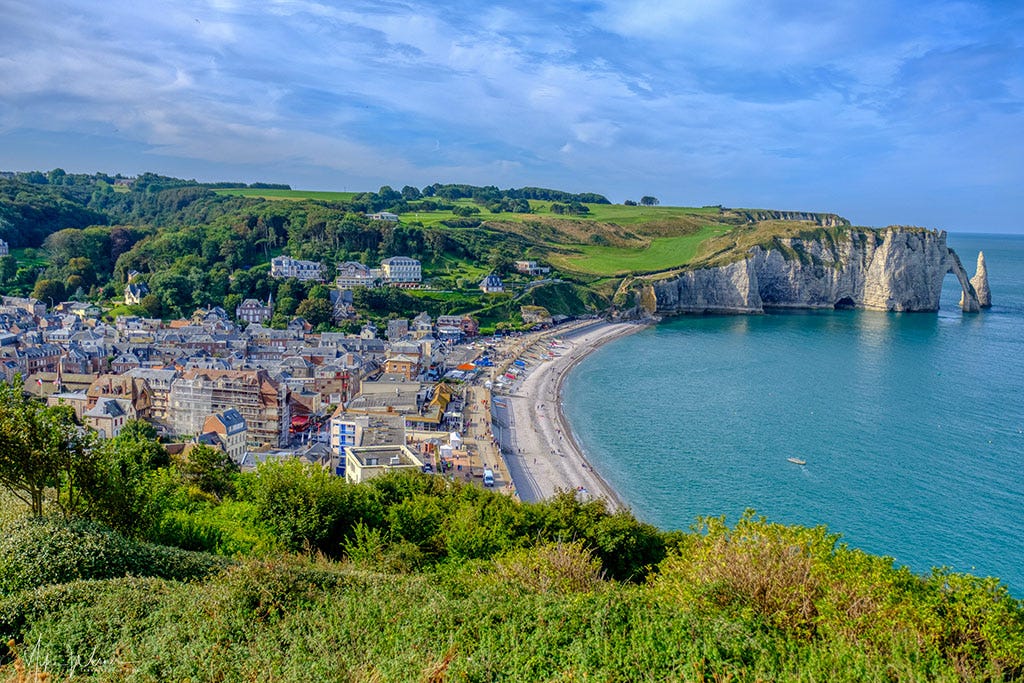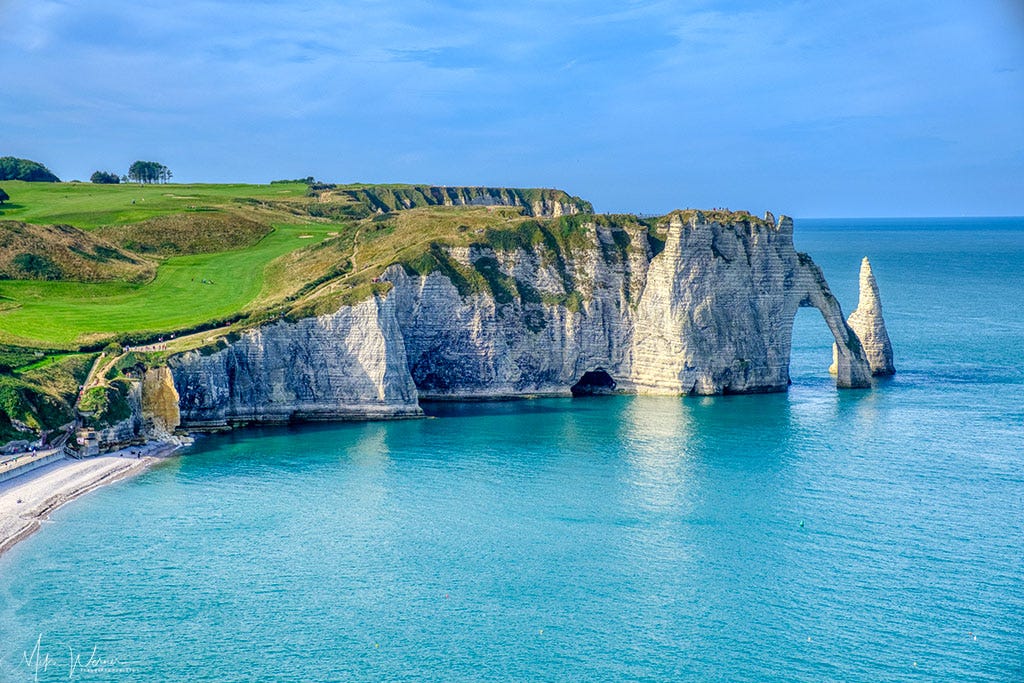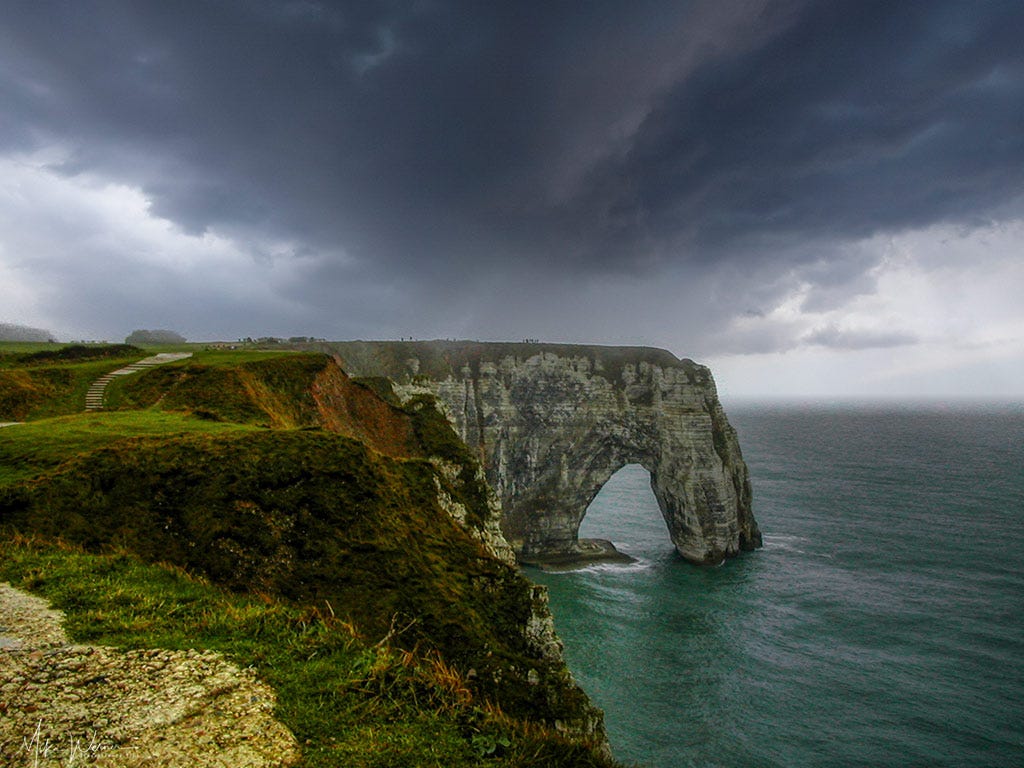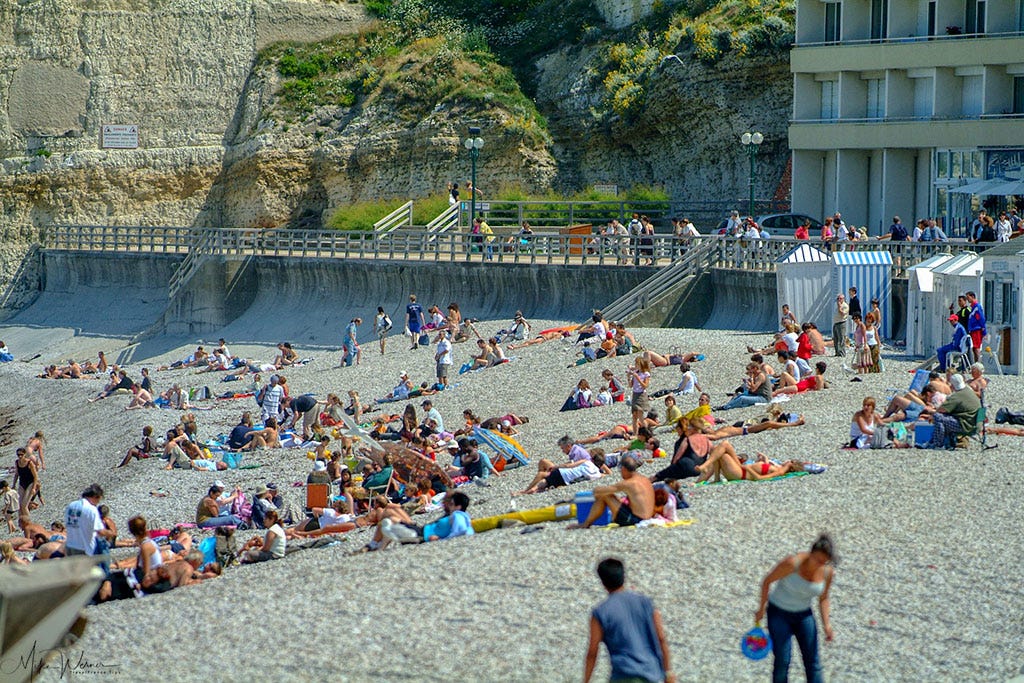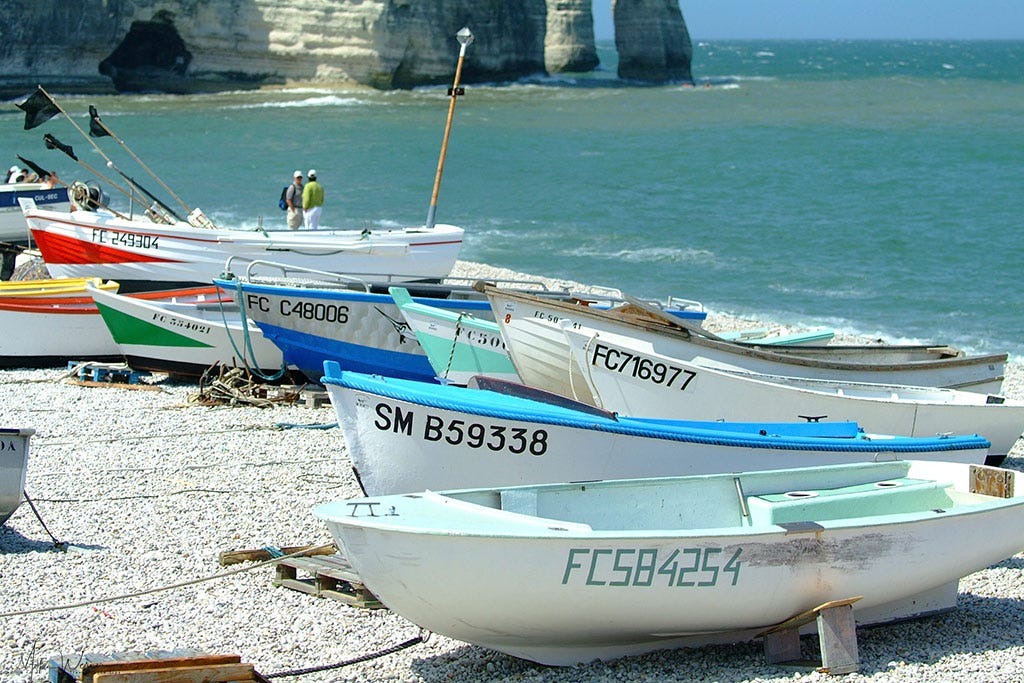Etretat is a small coastal town located in the Normandy region of France, on the English Channel. It is known for its stunning natural beauty, including white cliffs and a picturesque pebble beach. The town is situated on the Alabaster Coast, named for the white cliffs that resemble alabaster and has a population of approximately 1,500 people and attracts visitors from around the world.
The Cliffs
One of the most iconic landmarks in Étretat is the natural arch formation known as the Porte d'Aval, which is visible from the town's beach. One of the main attractions in Étretat is its cliffs, which have been shaped by the sea and wind over time, creating natural arches and formations that are breathtaking to see.
The Porte d'Aval is formed from white chalk cliffs that have been eroded by the sea over millions of years. The arch spans a gap between two cliffs and rises to a height of approximately 70 meters above sea level. It is best viewed from the beach below or from the top of the nearby cliff.
The Porte d'Aval has been immortalized in art by many famous painters, including Claude Monet and Gustave Courbet. It has also been featured in several films, including the 1991 movie "Les Enfants Terribles" by Jean-Pierre Melville.
Visitors to Etretat can take a walk along the cliffs to see the Porte d'Aval and other stunning natural formations in the area, such as the Porte d'Amont and the Aiguille d'Etretat. The cliffs and arches also offer great opportunities for hiking and photography.
The most famous of these is the "Aiguille" or needle, a tall, needle-shaped rock that rises from the sea, reaching a height of about 70 meters (230 feet). It is made of white chalk and flint, and is part of a larger chalk cliff formation that stretches for several kilometers along the coast.
The Aiguille d'Etretat is particularly famous for its striking shape and the dramatic views it offers of the surrounding coastline. Visitors can admire the rock from the beach, from the cliffs above, or from a hiking trail that leads to a viewpoint overlooking the Aiguille and the sea.
The Aiguille d'Etretat has also been a source of inspiration for many artists and writers over the years. It has appeared in paintings by famous Impressionist artists such as Claude Monet and Gustave Courbet, and has been the subject of poems and literary works.
The Porte d'Amont arch is located towards the northern end of Étretat's beach, and is formed from white chalk cliffs that rise up from the shoreline. The arch itself is a roughly rectangular shape, with a flat top and steep sides that curve inwards towards the center. At its highest point, the arch stands around 70 meters above sea level.
The Porte d'Amont is a popular tourist destination, and visitors can hike to the top of the cliff to enjoy stunning views of the arch and the surrounding coastline. It is also possible to walk through the arch at low tide, although this should only be attempted with caution and under the guidance of a local guide.
In addition to its natural beauty, the Porte d'Amont is also known for its cultural significance. It has been depicted in many works of art, including paintings by Claude Monet and Gustave Courbet, and was also featured in the opening scene of the 1961 film "The Longest Day".
La Manneporte is a beautiful natural arch that was formed by the erosion of the cliffs over millions of years.
The name "La Manneporte" means "the gate of the Manne" in French. According to local legends, the arch was named after a wealthy merchant named Manne who used to smuggle goods through the arch during the 17th century.
In addition to its natural beauty, La Manneporte also has cultural significance. It has been depicted in many paintings, photographs, and films over the years. One of the most famous depictions of La Manneporte is in the painting "La Manneporte, Soleil Couchant" by the French Impressionist painter Claude Monet.
Overall, La Manneporte is a beautiful natural wonder that is well worth a visit if you are ever in Étretat or the surrounding area.
The Beach
Étretat also has a beautiful pebble beach, which is popular with visitors and locals alike. The beach is surrounded by cliffs and offers stunning views of the coastline.
In addition to the beach and cliffs, there are also several hiking trails in the area that offer breathtaking views of the town and the surrounding landscape.
The Etretat beach is home to a land-based fishing fleet, where the boats are pulled onto the shore when not in use.
The Etretat Town
Another popular attraction in Étretat is the town's historic architecture, which includes several old churches, manor houses, and other buildings that date back to the Middle Ages. The town's architecture has been well-preserved, and visitors can take guided tours to learn more about the history of the area.
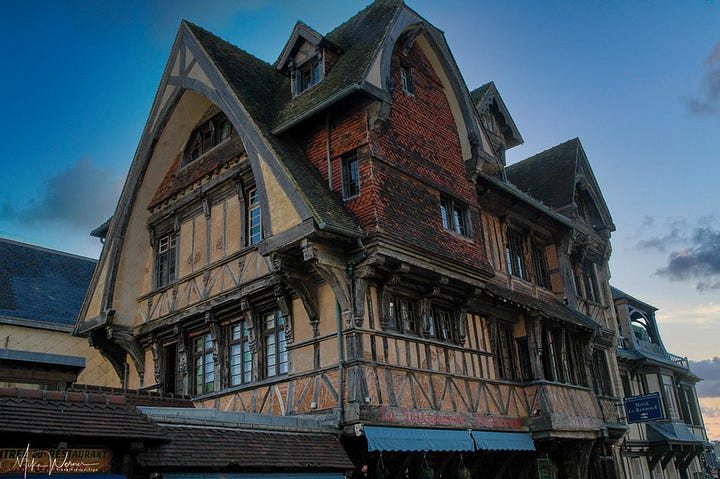
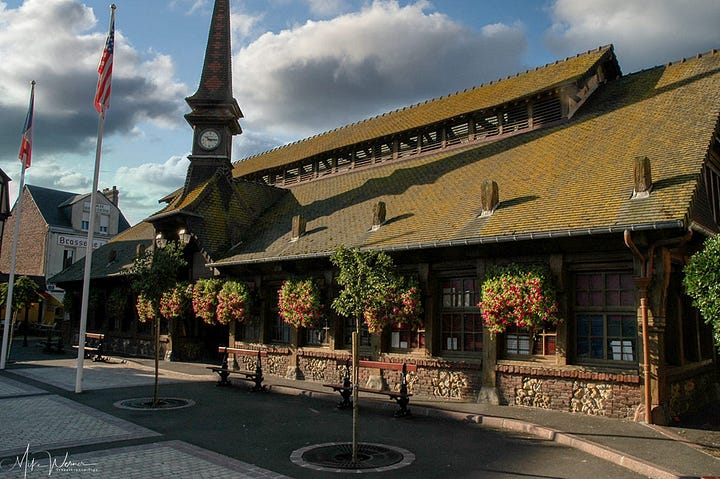
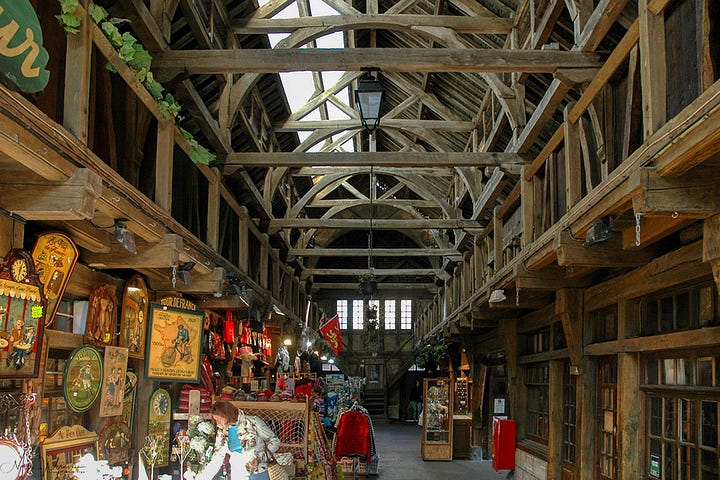

In addition to its natural beauty, Étretat is known for its fresh seafood, including oysters and mussels, which are harvested from the nearby coast. The town also hosts several festivals throughout the year, such as a seafood festival in October and a kite festival in September.
Many famous painters and writers spent time in Étretat during this period, including Claude Monet, who painted several famous works depicting the town's cliffs and beaches. Other notable visitors included Eugène Boudin, Gustave Courbet, and Guy de Maupassant, who lived in the town for several years and wrote many of his most famous stories there. Today, the town is a popular tourist destination, offering visitors a range of activities such as hiking, beachcombing, and exploring the town's museums and galleries.
Étretat has a long and fascinating history that dates back to prehistoric times. The area around the town was inhabited by Neolithic and Bronze Age peoples, and there are several dolmens and menhirs in the area that attest to this ancient history.
In the Middle Ages, Étretat was an important fishing village, and it played a key role in the region's economy. During this time, the town's port was a hub of activity, with fishermen bringing in catches of cod, herring, and other fish.
In the 19th century, Étretat became a fashionable seaside resort, attracting wealthy tourists from across Europe. The town's natural beauty and mild climate made it an ideal destination for those seeking relaxation and rejuvenation, and it soon became a popular spot for artists and writers.
Conclusion
Overall, Étretat is a beautiful and charming town that is well worth a visit for anyone interested in natural beauty, history, and architecture. With its stunning cliffs, fresh seafood, and rich cultural heritage, Étretat is truly one of France's hidden gems.




